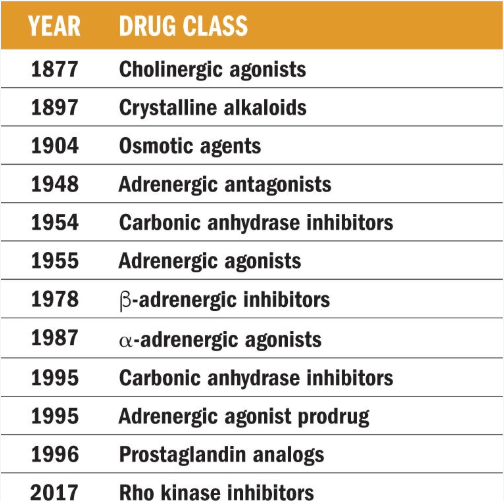Article
Tracing history of glaucoma drugs
Author(s):

The quest for safe and effective glaucoma medications is one of setbacks and successes, accidental discoveries, and decades of targeted research, as well as an ongoing effort.
Reviewed by Wallace L.M. Alward, MD
The history of glaucoma medications is punctuated by once-promising drugs since abandoned because of significant side effects or superseded by newer, more effective products as well as a few that have-so far-retained a place in the armamentarium alongside newer agents.
“We’ve come a long way, and new things are on the horizon,” said Wallace L.M. Alward, MD, Frederick C. Blodi Chair, Department of Ophthalmology, University of Iowa Carver College of Medicine, Iowa City.
Eserine (physostigmine) was the first glaucoma drug, a cholinergic agonist dating from 1876. Derived from the West African calabar bean, which caused pupils to become smaller, it was initially used for miosis in iridectomy cases, then found to lower IOP and break angle-closure attacks.
Pilocarpine was introduced just a year later, while it wasn’t until 1946 that the first indirectacting cholinergic agonist, diisopropyl fluorophosphate, was discovered, followed by echothiophate iodide (Phospholine iodide) in 1957.
Gel and extended-release formulations of pilocarpine were introduced as a means of decreasing the need for frequent dosing as well as reducing side effects-one physician described instilling eserine 40 to 50 times a day-and these remained the only successful long-term medical options for glaucoma until acetazolamide came onto the scene in 1954.
In the interim, the search for better glaucoma medication traveled down pathways such as crystalline alkaloids, including the rat poison strychnine, administered hypodermically in large doses to relieve the “mental and physical depression” of glaucoma, a contemporary physician reported in the 1890s.
Osmotic agents were added to the list of available agents in the early 1900s, starting with hypertonic saline in 1904, joined by glucose, urea, mannitol, and glycerol.
Next to find a place on the roster were the adrenergic antagonists, reaching the market in the late 1940s. Patients given intravenous dibenamine often experienced IOP levels dropping below 25 mm Hg for up to 24 hours.
Unfortunately, it was only effective if administered intravenously, Dr. Alward said, and had significant side effects such as severe orthostatic hypotension. Long periods of bed rest were recommended, and some deaths were reported.
Carbonic anhydrase inhibitors were introduced in 1954. Though still used today, these drugs are known for a host of side effects, he said. In 1955, adrenergic agonists followed the adrenergic antagonists onto the market.
Topical epinephrine lowered IOP but led to both topical and systemic side effects. In one study, 80% of patients had to discontinue therapy.
The IOP-lowering effects of beta-adrenergic antagonists were discovered in 1967, but problems such as decreased tear production, corneal anesthesia, and tachyphylaxis stalled commercial use until timolol was found to be both effective and well tolerated a decade later.
Following rapid FDA approval, Timoptic became available in 1978.
Flash forward to the 1980s
The alpha-adrenergic agonists were the next new class of glaucoma medication, introduced around 1987. Apraclonidine, a derivative of clonidine, was initially used with laser iridotomies to control bleeding.
“That didn’t actually work, but serendipitously it was found it prevented IOP spikes,” he said. Apraclonidine (Iopidine, Alcon Laboratories) was initially approved for post-laser IOP rise and in 1993 for chronic glaucoma management as well.
Brimonidine (Alphagan, Allergan), reaching the market in 1996, largely replaced apraclonidine. The 1990s also saw the culmination of decades of research into making a topical carbonic anhydrase inhibitor that would reduce the side effects of the oral version.
Dorzolamide (Trusopt, Merck), released in 1995, is still widely used. Another new approach in the 1990s was the adrenergic agonist dipivefrin (Propine, Allergan), a prodrug converted to epinephrine as it passed through the cornea.
It was hoped that it would reduce systemic side effects such as tachycardia and hypertension, and while this proved to be the case, dipivefrin, like other adrenergic drugs, it led to adverse effects such as topical allergies and is no longer available in the United States.
A much more successful class of glaucoma medication, also introduced in the mid-1990s, was the prostaglandin analogs. Discovered during research on the inflammatory cascade, their effectiveness at lowering IOP was demonstrated in animal models in 1982.
However, it was another 14 years before latanoprost (Xalatan, Pfizer) reached the milestone of being the first prostaglandin analog to receive FDA approval. Physicians quickly turned to Xalatan and other prostaglandins as their go-to medications due to their efficacy, safety, and daily dosing.
Preservative-free versions and prostaglandin-combination drugs have subsequently been approved, and the most recent advance was the 2017 approval of a nitric oxide-donating prostaglandin analog, latanoprostene bunod (Vyzulta, Bausch + Lomb).
The arrival of a new class of glaucoma drugs, the first major innovation in glaucoma therapy since the 1996 approval of prostaglandins, was signaled by the 2017 approval of netarsudil (Rhopressa, Aerie Pharmaceuticals), a Rho kinase inhibitor.
In March 2019, Aerie announced FDA approval of netarsudil/latanoprost ophthalmic solution 0.02%/0.005% (Rocklatan) for the reduction of IOP in patients with open-angle glaucoma or ocular hypertension.
Disclosures:
Wallace L.M. Alward, MD
P: 319/356-2228 E: wallace-alward@uiowa.edu
This article was adapted from Dr. Alward’s presentation during Glaucoma Subspecialty Day at the 2018 meeting of the American Academy of Ophthalmology. Dr. Alward did not report any relevant financial disclosures.
Newsletter
Don’t miss out—get Ophthalmology Times updates on the latest clinical advancements and expert interviews, straight to your inbox.

Study validates long-term efficacy of MicroPulse TLT for glaucoma management




